CIRCLE TIME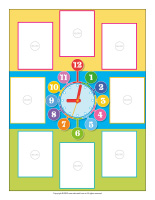
In the Educatall club, you will find numerous printable documents that can help you on a daily basis such as a task train, posters, a visual routine, motivational charts, etc. Use these tools to encourage children to participate in routines and to help them develop their autonomy.
Visit the Educatall club and pick various posters or tools that you feel will be useful for the children in your group. Print them and use them to decorate your daycare and simplify various tasks and activities. Each day, select one tool you wish to make a part of your routine. Once you feel children are comfortable with this tool, introduce another one. Among many other documents, children are sure to appreciate the toothbrushing chart, workshop posters, our visual routine, etc. (Open clock-Visual routine) Print and display at children’s eye level. Present the illustrations representing various routines to your group during circle time. As a group, arrange the illustrations in the correct order to provide a visual tool that children can follow as the day progresses.
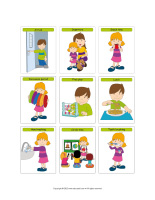
Accessories for each routine
Fill a bin with a variety of accessories used to complete various daily routines: toothbrushes, utensils, blankets, arts & crafts material, sandbox toys, empty soap hand soap bottles, toilet paper, towels, facecloths, books, sun hats, sunscreen, etc. Children can take turns picking one item out of the bin, naming it, and identifying the routine that it is associated with. For example, if a child picks a book, he may say, “This is a book. It is used for story time.”
AREA SETUP
(Open thematic poster-Routines) Print, laminate, and display all kinds of posters.
Educa-theme-Routines
(Open educa-theme-Routines) Print and laminate the different elements representing the theme. Use them to present the theme to your group (and children’s parents) while decorating your daycare.
Educa-decorate-Routines
(Open educa-decorate-Routines) Print, laminate, and cut out the illustrations. Use them to decorate your walls and set the mood for the theme.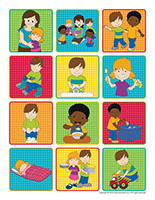
Stickers for rewards-Routines
(Open stickers-Routines) Print the illustrations on adhesive paper and use them to create a collection of unique stickers. Use them to reward children throughout the theme.
Routine mural
Hang a large piece of cardboard on a wall. At the top, write “ROUTINES”. Glue a clothesline under this title. Cut out illustrations representing different routines and hang them on the clothesline.
Advantages associated with routines:
- They help children follow the steps required to learn various tasks.
- They are reassuring, mostly because they help children know what is going to happen next.
- They foster autonomy, self-confidence, and self-control, three elements that are highly useful in terms of limiting the frequency of certain undesirable behaviors such as opposition and impulsiveness.
Number clocks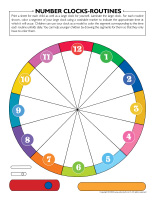
(Open number clocks-Routines) Print a sheet for each child as well as a large clock for yourself. Laminate the large clock. For each routine shown, color a segment of your large clock using a washable marker to indicate the approximate time at which it will occur. Children can use your clock as a model to color the segment corresponding to the time each routine unfolds daily. You can help younger children by drawing the segments for them so that they only have to color them.
PICTURE GAME
(Open picture game-Routines) Use the pictures to decorate your daycare or to spark a conversation with your group. Print, laminate, and store the pictures in a Ziploc bag or in your thematic bin.
Memory game-Routines
(Open picture game-Routines) Print the illustrations twice and use them for a memory game.
ACTIVITY SHEETS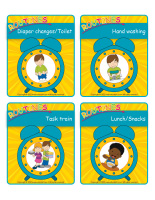
(Open activity sheets-Routines) Print and follow instructions.
WRITING ACTIVITIES
(Open writing activities-R like routine) Print for each child or laminate for use with a dry-erase marker.
Creating your own activity binder
Laminate several activity sheets and writing activities and arrange them in a binder along with dry-erase markers. Leave the binder in your writing area and let children complete the pages as they wish. At the end of the day, simply wipe off their work so the activity binder can be reused over and over again.
LANGUAGE ACTIVITIES
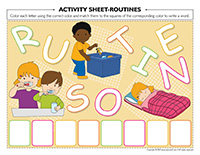
Word flashcards
Use the flashcards to spark a conversation with your group, in your reading and writing corner, or to identify your thematic bins. (Open word flashcards-Routines) (Open giant word flashcards-Routines) Print. Arrival/Departure, Circle time, Transitions, Getting dressed/Getting undressed, Hand washing, Teeth brushing, Diaper changes/Toilet, Lunch/Snacks, Clean up, Naptime/Relaxation, Task train, Games/Outdoor play.
ROUTINES-ARRIVAL AND DEPARTURE
Daily routine
(Open daily routine) Print and divide the daily routine into several steps, from the time children arrive to the time they leave. Illustrate each routine using pictures that can be arranged in order in a row or column or even pressed on a clock. If you choose the latter option, simply move the clock hand to indicate your group’s progression throughout the day.
Tricks to simplify this routine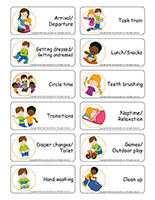
- Be sure to say hello to each child as he/she arrives.
- Avoid long conversations with parents.
Here I am!
(Open attendance chart) Print and laminate. Display the attendance chart close to your daycare entrance or on the door. As children arrive, they can, with their parent’s help, position their label on the chart to indicate they have arrived.
Days of the week
(Open days of the week) Print, laminate, and cut out. Children can associate each day to the piano by matching the colors.
ROUTINES-CIRCLE TIME
Tricks to simplify this routine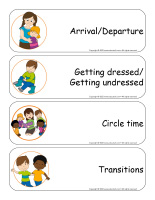
- Draw a large circle on the floor (use chalk or electrical tape). Add the first letter of each child’s name next to his/her spot.
- Provide stickers children can use to decorate their circle time spot. This will make it easier for them to recognize where they are to sit during circle time.
- Use different stickers depending on your theme or the season. For example, use snowflakes during winter, hearts around Valentine’s Day, etc.
- Depending on the ages of the children in your group, you may also choose to use a number, a symbol, a shape, an animal, or a color to identify each child’s spot.
Gathering sounds
Encourage each child to pick a sound. When you are ready, use your mouth to produce each sound to invite children to join you for circle time. Here, the sounds may or may not be related to your current theme.
Light signal
Turn the lights on and off in a rhythmic fashion to signal to your group that it is circle time. If your group is very active, this represents a calm way to let them know they need to stop what they are doing and join you. Have fun using this light signal several times throughout the day to provide children with the opportunity to practice gathering as quickly as possible.
Routine game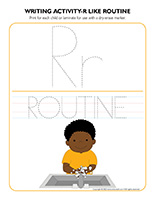
(Open routine game) Print, laminate, and cut out. Associate each symbol to the corresponding time of the day: morning, lunch time, afternoon, or evening.
I find my spot super fast
Gather in one corner of your daycare. Show children an object they will have to search for. Ask them to turn around while you hide it. The object should be somewhat visible and children should not have to move other items around to find it. When you give the signal, children must search for the object with their hands behind their back or on their head. As soon as a child sees the object, he/she must sit down on his circle time spot. Once all the children have found the object, the game starts all over again.
Sequential story
(Open tools-visual routine) Print. Ask children to place the illustrations in the correct order, according to when they occur during the day.
Rallying cry
Invent an original rallying cry for your group. Explain to your group when and why you will use it (if they are old enough). Use your group name or your daycare name for inspiration. Every time you call out the first line of your rallying cry, children must complete it and then remain perfectly quiet while you explain the upcoming activity or routine. For example, you could say, “My little mice say…” and your group could complete the cry by making mice sounds.
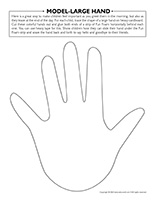
Let’s wave hello and goodbye
Here is a great way to make children feel important as you greet them in the morning, but also as they leave at the end of the day. For each child, trace the shape of a large hand on heavy cardboard. (Open model-large hand) Cut these colorful hands out and glue both ends of a strip of Fun Foam horizontally behind each one. You can use heavy tape for this. Show children how they can slide their hand under the Fun Foam strip and wave the hand back and forth to say hello and goodbye to their friends.
Free play chart
(Open free play chart) Print and laminate the chart as well as the pictures representing various activities that children can choose from. Each day, use adhesive putty to press activity suggestions for free play periods in the boxes. The pictures will help children find an activity to enjoy. Using a dry-erase marker, they can draw an “X” on the activity they select to indicate that the required material is no longer available for others. When they change activity, they can erase the “X” to announce that it is available again.
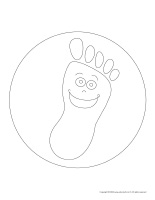
ROUTINES-TRANSITIONS
Transition wind chime
Hang a wind chime in the center of your daycare for the duration of the theme. Every time you move from one activity or routine to the next, pick a child up in your arms and have him pull on the string to produce a jingling sound. This will serve as a signal that it’s time to move on to something new.
Wiggly worms
Here is a great game to get children moving during a waiting period or, for example, right before circle time to rid your group of any extra energy they may have. You will need a brown paper lunch bag as well as brown construction paper. Cut the paper into strips to represent worms. On each strip draw a worm, an arrow, or a heart. Drop the strips of paper in the bag. Have children stand in a circle. Pass the bag around the circle to the sound of music. When the music stops, the child who is holding the bag pulls a worm out of the bag. If a worm is drawn on it, children dance and wiggle like a worm. If there is an arrow on the worm, they must all trade places with a friend. If a heart is drawn on the worm, each child hugs the child on his right.
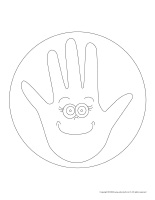
My floor-Routines
(Open my floor-Routines) Print and have children color the pictures. Cut them out and press them on the floor using adhesive paper to delimit routines or to create a path that connects various areas within your daycare.
Tricks to simplify this routine
- When you are moving from one activity to another, encourage children to move about like different types of animals or to sing songs.
- Use pictograms as reference points in your hallways to help children respect your rules and requests. For example, you can stick fun illustrations on the railing they are supposed to hold on to as they go up and down stairs. You can also use traffic signs to indicate which way they must go, etc.
Follow the chief
Children stand single file behind you. They must imitate your every move. If you lean towards the right, children must do the same. If you raise your right arm, they must also raise their right arm, etc.
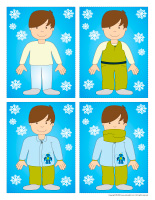
Guided tour
Encourage children to stand single file, holding the waist of the child in front of them to form a train. Announce that the train will be departing shortly. Make train-like sounds with the children in your group. Guide children to a specific area, for example your kitchen area. When you arrive, say, “Stop! We have arrived. This is our kitchen.” Invite children to explore the area for a few minutes. Take advantage of the time spent in each area to inform children of the areas they may or may not have access to as well as the rules that must be respected. After a while, children hop back on the train so you can take them to another area.
ROUTINES-GETTING DRESSED AND UNDRESSED
The getting dressed routine
(Open getting dressed for winter routine) Print or illustrate the getting dressed routine and use it to help children get dressed independently. You can use the illustrations as a list of steps that children can check off or present it as a card game. Children can simply set the cards representing completed steps aside.
Who do these items belong to?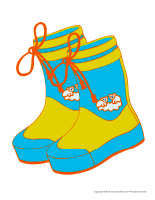
Pick up a pair of boots or mittens. The child they belong to must hide. When a child arrives, invite him to guess who they belong to. Once he has identified the owner, he can go looking for him.
Tricks to simplify this routine
- With younger children, help them put a single clothing item on at a time so they don’t get too hot. For example, let them try to put their nylon pants on as you help one child. This will help them develop their autonomy.
- Transition bins can really help keep children quiet during this routine that can sometimes seem to take forever.
- Show children how they can place their coat upside down in front of their feet, insert their arms, and then pass their coat over their head. They will love this fun technique!
Getting dressed in the correct order
(Open winter clothes) Print, laminate, and hang the illustrations in your cloakroom to represent a clothesline. They will help children recognize the correct order for getting dressed to go play outside.
Hunt and seek-Routines
(Open hunt and seek-Routines) Print and laminate. Display several different hunt and seek activities on the walls of your cloakroom. Visit the hunt and seek section of the Educatall club. Children who get dressed very quickly can keep busy hunting for the different items in the scenes as they wait for the others to be ready to head outside.
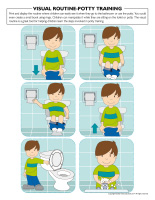
My early childhood educator says…
Play a game of “Simon says” with your group to help children get dressed. Simply say, “My early childhood educator says…” and complete the sentence suggesting one clothing item at a time.
ROUTINES-HYGIENE (HAND WASHING, TOILET, TOOTHBRUSHING, DIAPER CHANGES…)
Visual routine-Potty training
(Open visual routine-Potty training) Print and display the routine where children can easily see it when they go to the bathroom or use the potty. You could even create a small book using rings. Children can manipulate it while they are sitting on the toilet or potty. The visual routine is a great tool for helping children learn the steps involved in potty training.
A bathtub in our daycare
Fill a kiddie pool with water and add a few drops of bubble bath along with rubber ducks, colorful facecloths, towels, small boats, etc. Children can wear their bathing suit and pretend to take their bath.
To each his facecloth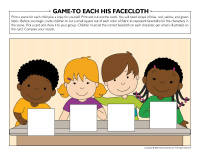
(Open game-To each his facecloth) Print a scene for each child plus a copy for yourself. Print and cut out the cards. You will need scraps of blue, red, yellow, and green fabric. Before you begin, invite children to cut a small square out of each color of fabric to represent facecloths for the characters in the scene. Pick a card and show it to your group. Children must set the correct facecloth on each character, per what is illustrated on the card. Compare your results.
Hand washing counting exercise
(Open Hand washing counting exercise) Print and laminate the posters. For each of their peers, children will enjoy counting the actions required throughout the hand washing routine.
Tricks to simplify this routine
- Offer different types of soap. Sele
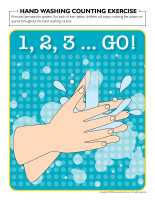 ct different scents and colors to encourage children to want to wash their hands.
ct different scents and colors to encourage children to want to wash their hands.
- Colourful facecloths can be used to wash children’s hands and face after snacks or at lunch time.
- Every day, use a special item to make your handwashing routine fun: a sponge, a facecloth, a small brush, etc. Children will look forward to seeing what the daily object is.
- A plastic puppet can be used to add a touch of humour to these routines.
I am calling you…
Call children to come wash their hands or brush their teeth one bye one by naming a color they are wearing or a unique characteristic.
Follow the path
(Open pictures-toilet) (Open pictures-faucet) Print and laminate the pictures. Arrange them on the floor to create a path. Ask children to stand on the illustrations to wait for their turn to wash their hands or brush their teeth. The illustrations can be used to decorate your bathroom too.
I am washing my hands with…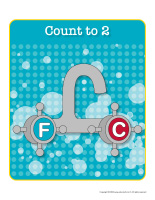
During your handwashing routine, present a variety of objects children can use to wash their hands: sponges, facecloths, brushes, pretty towels, etc.
Brush, brush, brush
Purchase several different toothbrushes. Use them to create a fun bin. Children can use the contents of this bin to practice their tooth brushing technique.
Pump, pump, pump
Ask children to sit at the table or to stand with their back against a wall, close to the sink. You will need different kinds of liquid hand soap. Wrap the bottles so that children can’t see the contents. You will also need a spray bottle filled with lukewarm water. Use the spray bottle to moisten children’s hands. Have each child select a bottle of soap and pump the soap into their hands. Encourage them to lather the soap and guess what the scent is. Children can take turns rinsing their hands at the sink.
ROUTINES-LUNCH AND SNACKS
Lunch time routine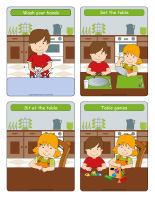
(Open routine-Lunch) Print and present the images on a magnetic board displayed in the kitchen. Another fun way to present the images is to glue them on a jar and fill it with spoons. Beyond using these visual tools, do not hesitate to animate lunch time. To keep children busy during this period, you could create special activity placemats or print riddles on cookie-shaped cards and set them in a jar on the table.
I am setting the table
(Open game-I am setting a colorful table) Print and laminate the placemats. Fill a bin with paper plates and glasses as well as plastic utensils and disposable straws. Pick items that are the same colors as the items illustrated on the placemats. Invite children to pick a placemat, find the plate, glass, straw, and utensils of the corresponding colors and set them in the correct places, like a puzzle.
Game-In my plate
(Open game-In my plate) Print and laminate a placemat for each child. Each day, children can search for and circle the foods that they eat using a dry-erase marker.
Tricks to simplify this routine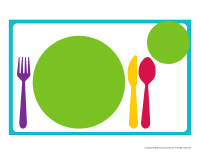
- Create a task chart that regroups the main tasks surrounding snack time and lunch time.
- A tablecloth, placemats, napkins, candles, etc. All these items can make these routines interesting.
- Teach children to wait for you to be done eating before they may ask for seconds.
- Serve meals in a variety of different ways. Pretend you are a waitress in a restaurant, invent fun names for the foods you serve, etc.
- Adding a drop of food coloring to children’s glass of milk will make it possible to invent different “flavors” and encourage them to drink up.
- Provide simple games to help children wait for their lunch or snack.
Clean hands bins
Fill several small bins with tiny toys children may use only at snack time or lunch time, and what’s more…only if their hands are clean.
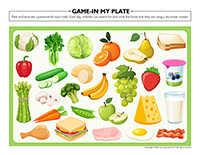
Personalized placemats
Provide a wide range of material. Invite children to use the material to create a collage you can later laminate to make placemats. This is a great activity for younger children. Using their placemats will help them remain seated at lunch time. If you wish, you can encourage them to cut food items they like out of grocery store flyers and use them to decorate their placemat. This activity can help you learn which foods children appreciate.
Find your spot
Glue a sun, a flower, or any other shape on which a number is printed on each chair at the table. Keep a copy of each numbered item. At lunch or snack time, have children pick a number to determine where they are to sit.
ROUTINES-CLEANUP
Pennants-Routines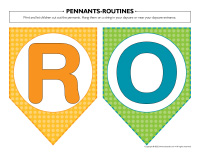
(Open pennants-Routines) Print and let children cut out the pennants. Hang them on a string in your daycare or near your daycare entrance.
Tricks to simplify this routine
- Name a “Cleanup inspector” each day. He/she will be responsible for making sure all the toys are put away.
- Identify bins with pictures or illustrations to simplify cleanup time. Children and other early childhood educators who work in your daycare will know where each item belongs.
- Make sure your bins are the right size so that toys are easy to put away.
- You could have a “lost toy bin” for any small parts and accessories that you find. At the end of the day (or week) ask children to try and find which toy or game each part belongs to.
Cleanup race
When play time is over, ask children to stop what they are doing. Count to 10 before saying “Go!” Children must then rush to pick up all the toys as quickly as possible. Time them and write the result on a board. Encourage them to try to beat their record every time.
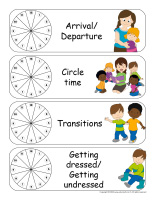
Task train
(Open the task train) Print, laminate, and cut out. Display the train in your circle time area. To distribute tasks, you can, for example, place the pictograms representing the children in your group face down on the floor. Pick one pictogram at a time and let the child it represents pick his/her task. If you prefer, you could also arrange the various task pictograms face down on the floor. Pick one task at a time and invite children to raise their hand if they are interested. You could also play musical ball. The child holding the ball when the music stops gets to pick his/her task.
Toy collection
Give each child a plastic bag with handles. Ask them to fill their bag with the toys that are on the floor. When their bag is full, encourage them to return each item to the right spot.
Color sorting
Ask children to put all the toys of a specific color away. When they are done, suggest a new color.
Counting cleanup
Have each child put 5 toys away, then 4, then 3, and so on… Continue until all the toys have been picked up.
Singing cleanup
Play a song and tell children that all the toys must be put away before the song ends.
Quick cleanup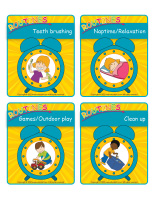
Place all the toys children have played with in the centre of your daycare. When you give the signal, children must grab as many toys as they can and rush to put them in the right place. They must continue until all the toys have been put away.
A few extra ideas
- Collect empty baby wipe containers and use them to store scraps of paper, puzzle pieces, etc. Glue a label on each container to identify its contents.
- Use shoeboxes to store figurines. Wrap them in adhesive paper that has fun designs printed on it.
- Collect egg cartons and use them in your arts & crafts area. Pour glue or poster paint in the different sections and simply discard them when you are done.
- Use a storage bin on wheels in your arts & crafts corner. It will be great for storing paper, cardboard, felt, crayons, etc.
- Punch holes out of empty baby food jar lids. Fill the jars with glitter to make homemade shakers.
- Cut empty cereal boxes on the diagonal and wrap them in pretty paper. They can be used to store coloring pages.
- Use baskets or plastic bins that can be stacked to store plastic food items and dishes in your kitchen play area.
- Use shoe bags to store children’s change of clothes.
- Press hooks on a wall and identify them using pictures of the children in your group. Children can hang their personal belongings on the hooks.
ROUTINES-NAPTIME AND RELAXATION PERIOD
(Open naptime routine) Print. The visual routine is a great way to introduce a ritual that is both regular and predictable to help children prepare for naptime. Its purpose is to reassure children. You can simply display it and use Velcro or magnets to add the illustrated steps.
Yoga routine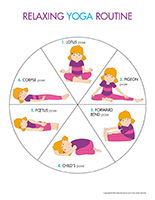
(Open yoga routine) Print and use to integrate a relaxing daily yoga routine. Guide children through the various poses, giving them simple instructions. Use a soft voice. Repeat the sequence daily with your group. Eventually, children we be able to complete it autonomously.
Labels-Naptime containers
(Open labels-naptime containers) Print on adhesive paper. Naptime containers are great for keeping children busy right before naptime or when they wake up before their peers. Create bins using different containers filled with figurines, puzzles, Lego blocks, toy cars, dominoes, and other calm activities.
The naptime star
(Open naptime star) Print the star and use it as needed. Children can add a star after naptime. Once they have collected 5 stars, grant them a tiny privilege.
Tricks to simplify this routine
- Calm, relaxing music.
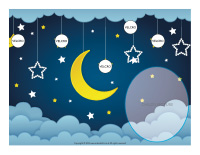
- Create a naptime ritual complete with a mascot, magic powder, etc. Calling upon children’s imagination will make this routine magical.
- Stick glow-in-the-dark items on the ceiling and walls in your naptime area.
- Use different types and colors of lighting depending on your themes. For example, you can purchase fun nightlights.
Outdoor relaxation
Set a large blanket on the ground. Hold a timer in your hands. Invite children to lie down on the blanket and relax until your timer rings. Encourage them to admire the clouds, listen to the birds and the wind, etc.
Breathing techniques
Show children the difference between breathing in and breathing out. Show them how their tummy gets bigger when they breathe in and smaller when they breathe out.
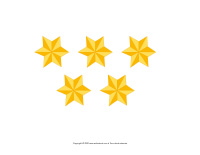
Calming exercise
Each child finds a partner. Have them take turns massaging each other. They can, for example, roll a toy car on their partner’s back, arms, and legs or gently sweep a feather over their partner’s skin. At first, children may laugh a lot, but they will eventually calm down.
Yoga
Show children a few yoga poses or use a relaxation CD with guided instructions.
Naptime containers
(Open naptime containers-Routines) Print and display on your storage closet. Naptime bins are a great way to help children calm down before naptime or to keep older children busy if they wake up early. You can use a variety of containers (gift bags, wipes, Pringle chips, yogurt). Ideally, you should have several series of naptime containers available at all times. Here are a few ideas:
- Figurines of all kinds.
- Miniature dry-erase boards.
- Tiny toys.
- Paper and crayons.
- Lacing activities.
- Miniature stuffed animals.
My naptime spot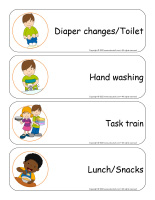
(Open game-This is my spot-Routines) Print two copies and laminate. Arrange the illustrations on the floor in your naptime area. Have children pick a card to determine their naptime spot for the day or week.
ROUTINES-STORY TIME
Tricks to simplify this routine
- Sing a short song to capture children’s attention and inform them that it is story time.
- Insert your book in a special decorated box used specifically for story time.
- Use accessories and various items to compliment the story you are reading.
- Use storybooks, book and CD sets, short movies, etc.
My story time spot
(Open Game-This is my spot-Routines) Print and laminate. Arrange the illustrations on the floor to determine each child’s spot for story time. Print two copies. Have children pick a picture and sit on the corresponding picture, on the floor.
Let’s invent a story
Print several pictures and illustrations from a variety of different themes. Arrange them face down on the floor. Display one illustration at a time. Children must use it as inspiration to invent a story. After a few minutes, display a second illustration and encourage them to continue their story. Prepare for a very silly story!
ROUTINES-TASKS AND RESPONSIBILITIES
Homemade routines poster
Cut several images representing various activities that are part of your daily routine out of magazines. Laminate them and use a hole-punch to make a hole at the top of each one and thread a long piece of ribbon through each hole. Hang them from the ceiling, over the area where each routine unfolds. For example, you could hang a picture of children washing their hands over the sink in the bathroom, a picture of children eating over your table, a picture of children playing outside over the door children use to go outside, etc.
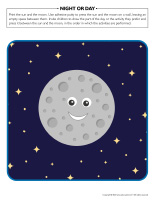
Task train
(Open the task train) Print, laminate, and cut out. Display the train in your circle time area. To distribute tasks, you can, for example, place the pictograms representing the children in your group face down on the floor. Pick one pictogram at a time and let the child it represents pick his/her task. If you prefer, you could also arrange the various task pictograms face down on the floor. Pick one task at a time and invite children to raise their hand if they are interested. You could also play musical ball. The child holding the ball when the music stops gets to pick his/her task.
Pick a picture
Set a picture of each child in your group in a box. Use this box to determine the order in which children get to pick their task or responsibility. Simply pull a picture out of the box and invite the photographed child to select what he wants to be responsible for.
ROUTINES-GAMES AND OUTDOOR PLAY
Find your spot
Glue a sun, a flower, or any other shape on which a number is printed on each chair at the table. Keep a copy of each numbered item. At lunch or snack time, have children pick a number to determine where they are to sit.
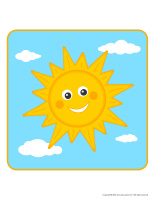
Hop around
Set shapes cut out of colorful paper on the ground and encourage children to hop on them in a variety of ways: on 2 feet, backwards, alternating feet, etc.).
Giant hopscotch game
Using adhesive tape, draw a giant hopscotch game on the ground. You can use it to connect 2 areas within your daycare.
Game-This is my spot-Let’s get moving
(Open game-This is my spot-Let’s get moving) Print 2 copies of each illustration. Press one copy of each illustration on a table using adhesive paper. Set the other copy in a bag. Children take turns picking a card out of the bag to determine where they shall sit at the table. These cards can also be used for the task train or naptime spots.
My clock
(Open I’m learning to tell time) Print, laminate, and assemble the clock. Set the small cards displaying different times face down on the table. Children pick a card and place the hands on the clock to represent the illustrated time.
My day
(Open night or day) Print the sun and the moon. Use adhesive putty to press the sun and the moon on a wall, leaving an empty space between them. Invite children to draw the part of the day or the activity they prefer and press it between the sun and the moon, in the order in which the activities are performed.
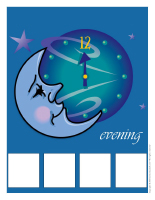
Hula hoop targets
Set hula hoops on the ground to represent targets. Have children toss bean bags, balls, or balloons towards them. You could also hang the hula hoops on a fence or wall.
It’s dark
Give children flashlights. Turn the lights off and close the curtains to make your daycare as dark as possible and represent nighttime. Children will enjoy observing objects with their flashlight. After a while, turn the lights back on and say, “Good morning!”
Outdoor relaxation
Set a blanket on the ground in your yard. Hold a timer in your hands. Ask children to lie on their back and relax until the timer rings. Encourage them to observe the clouds, listen to the wind and the birds, etc.
For one day
(Open routine game) Print, laminate, and cut out the illustrations. Associate each symbol to the correct time of day: morning, noon, afternoon, evening.
COLORING PAGES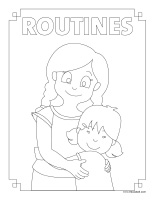
(Open coloring pages theme-Routines) Print for each child.
Creative coloring-Routines
(Open creative coloring-Routines) Print for each child. Have them draw the time of day that they enjoy the most.
Have fun!
The educatall team
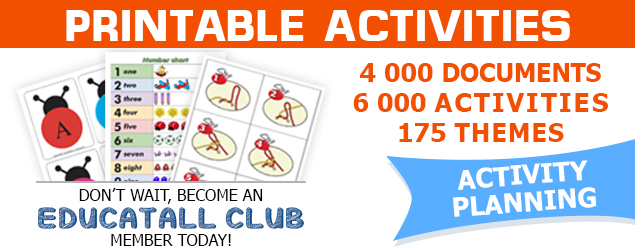
 Home
Home Theme activities
Theme activities
 Babies and toddlers
Babies and toddlers
 Arts and crafts
Arts and crafts
 Science
Science
 Creative recipes
Creative recipes
 Tips and tricks
Tips and tricks
 Special needs
Special needs
 Extra activities
Extra activities
 Educ-TV
Educ-TV
 Newsletter
Newsletter  Online store
Online store Educatall club
Educatall club

